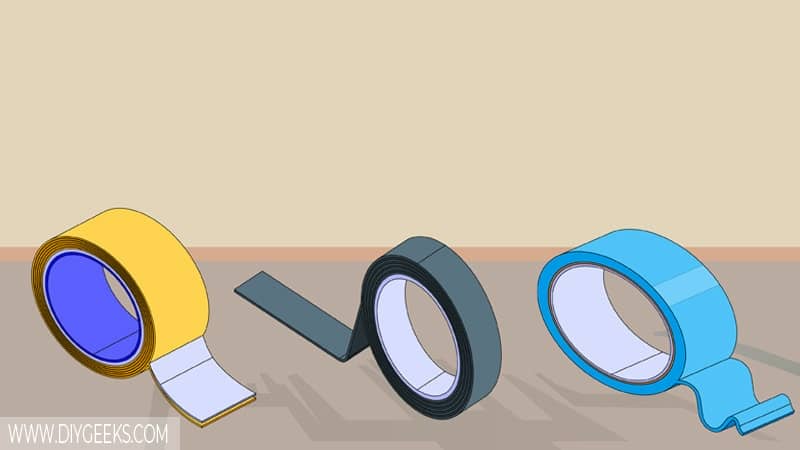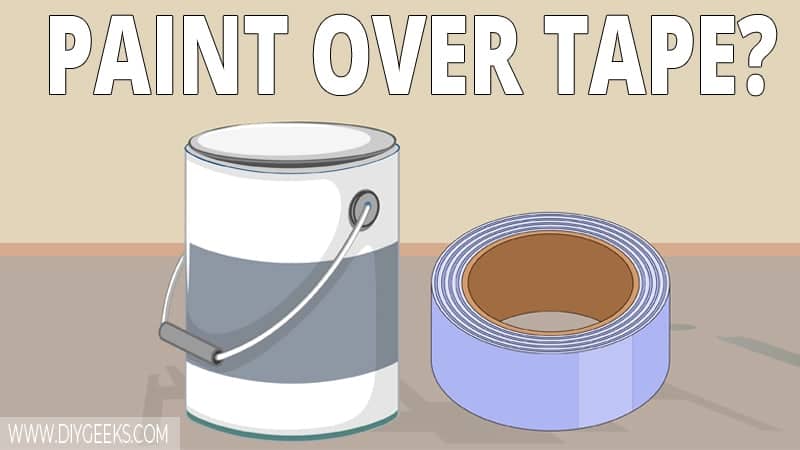You can paint over most tape types, but not all of them. Some tape types, such as painter’s tape, are specially made to accept paint coatings, while some other types don’t allow penetration.
To paint over tape, clean the surface, place a paintable tape on the surface, apply paint, remove the tape, and touch up the edges.
Does Paint Adhere to Tapes?
Paint does adhere to most tape types, but not all of them. For instance, you can paint over painter’s tape as it’s designed to accept paint coatings, but you can’t paint over duct tape as its surface prevents paint penetration.
Most tapes are designed to join materials together, and not be painted over because they have a rubber-like and slick surface that prevents penetration. However, some paint types are specially made porous to absorb paint and create clean lines.
If you paint over non-paintable tape, the paint won’t adhere properly and can peel off because the tape’s slick surface prevents penetration. If a paint coating can’t penetrate a surface, it won’t adhere.
If you paint over paintable tape, the paint penetrates the tape surface and adheres to it. You can remove the tape to create clean paint finish lines. Most paintable tapes are made from paper or crepe materials.
Which Paint Types Can You Apply Over Tape?
The paint types you can apply over tape are listed below.
- Latex Paint: You can apply latex paint over painter’s tape, but not over other types.
- Enamel Paint: You can apply enamel paint over tapes with textured surfaces only. Enamel paint doesn’t adhere over slick or glossy tapes as the paint has high levels of oils and will slide off.
- Acrylic Paint: You can apply acrylic paint over most tapes as the paint has impressive adhesive qualities. But, the paint is thin and if applied over a tape with strong glue, the coating can come off.
- All water-based paint types.
- All oil-based paint types.
How To Paint Over Tape?
To paint over tape, do the following things.
- Clean the Surface.
- Place a Paintable Tape on the Surface.
- Apply the Paint.
- Remove the Tape.
- Touch up the edges.
The tools you need for this project are listed below.
- The required tape (preferably painter’s tape)
- A gallon of paint
- A paintbrush
- Clean rags
- Dish soap
- A bucket of water
- A pair of work gloves
1. Clean the Surface
Clean the surface to remove dust, dirt, debris, or stains that can prevent the tape and paint from adhering.
To clean a surface before painting, do the following things.
- Mix water with dish soap.
- Damp a rag with soapy water.
- Use the dampened rag to clean the surface.
- Rinse the surface with clean water.
- Allow the surface to dry.
2. Place a Paintable Tape on the Surface
Place the paintable tape on the surface. Ensure to apply pressure and place it correctly without having to remove and replace it. Wait a few minutes for the tape to properly adhere to the surface.
3. Apply the Paint
Apply paint or primer coating over the paintable tape. Ensure to not apply too many coats as you can’t remove the tape afterward.
4. Remove The Tape
Once the final paint coating dries, remove the paint by pulling it. The paint dry time depends on the paint type, and room humidity and temperature.
If you remove the tape before the paint is dry, the finish gets ruined as you can remove parts of it.
5. Touch Up The Edges
Touch up the edges if you see patches in the finish after removing the paint.
What Tape Types Can You Paint Over?

Painter’s Tape
You can paint over painter’s tape as it’s designed to accept paint coats. It’s made of crepe paper, has a textured surface and low level of glue, and absorbs paint coatings.
Masking Tape
You can paint over masking tape because it has a textured surface that absorbs paint coatings. But, it has a strong adhesive and can pull off the entire paint finish if not careful.
Drywall Tape
You can paint over paper drywall tape, but not over fiberglass mesh drywall tape. Paper drywall tape has a textured surface and accepts paint penetration. Fiberglass mesh drywall paint has tiny holes and squares that don’t accept paint evenly and create an uneven finish.
Clear Tape
You can paint over clear tape, but you can’t remove it afterward. Clear tape is transparent (colorless) and it’s hard to find it after applying a paint coating over it.
Gorilla Tape
You can paint over gorilla tape, but you shouldn’t. The tape is made from rubber-based adhesives and can remove the entire finish when you pull it.
Duct Tape
You can’t paint over duct tape as it has a waterproof slick surface that prevents paint penetration. If you paint over it, the finish will have poor adhesion and will get removed eventually.
Scrim Tape
You can’t paint over scrim tape as it’s made from fiberglass threads woven together and has pores and space between that don’t absorb paint evenly.
Scotch Tape
You can paint over scotch tape as it has a slick and shiny surface that prevents penetration.


